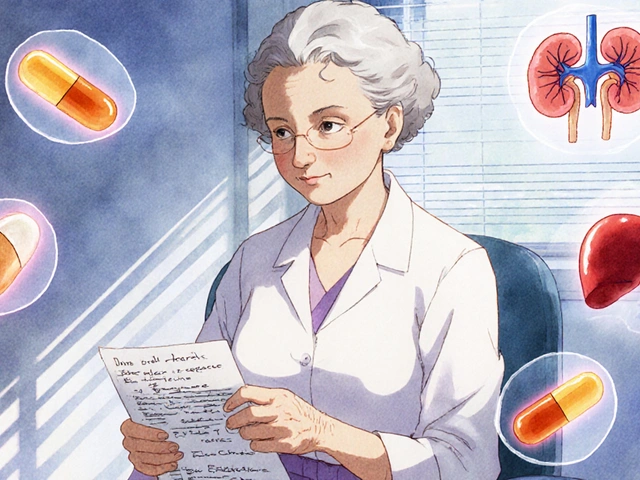
Cabergoline is a long‑acting dopamine‑agonist medication originally approved for Parkinson’s disease and hyperprolactinemia. It binds to dopamine D2 receptors in the pituitary gland, suppressing excess hormone secretion. In the context of acromegaly, Cabergoline reduces elevated growth hormone (GH) and downstream insulin‑like growth factor‑1 (IGF‑1) levels, offering a medical alternative to surgery or more costly injectable drugs.
Why Acromegaly Needs More Than One Treatment Option
Acromegaly is a rare endocrine disorder caused by a GH‑secreting pituitary adenoma. Persistently high GH drives liver production of IGF‑1, leading to tissue overgrowth, cardiovascular disease, and reduced lifespan. Traditional first‑line therapy is transsphenoidal surgery, which removes the tumor in 70‑80% of cases when performed by experienced surgeons. However, up to 30% of patients either retain active disease post‑op or face tumor recurrence, necessitating adjunct medical therapy.
How Cabergoline Controls Hormone Levels
Cabergoline’s mechanism hinges on dopaminergic inhibition of somatotroph cells. By activating D2 receptors, it dampens intracellular cAMP, curbing GH synthesis and release. Clinical studies from the early 2000s to today show that low‑ to moderate‑dose Cabergoline (0.5-2mg weekly) normalizes IGF‑1 in roughly 30‑40% of treatment‑naïve patients and up to 60% when combined with a somatostatin analogue.
Clinical Evidence - Numbers That Matter
- In a multicenter European trial of 214 patients, Cabergoline alone achieved biochemical control (IGF‑1 <1×ULN) in 35% after 6months.
- When added to Octreotide, the control rate rose to 58%, demonstrating synergistic action.
- Long‑term safety data (median 7years) report a valve‑regurgitation incidence of <1% at doses ≤2mg/week, far lower than the >5% seen with higher‑dose dopamine agonists used for Parkinson’s.
These figures come from the International Consensus on Acromegaly (2023) and national registries in Sweden, the UK, and Australia.
Comparison With Other Medical Options
| Attribute | Cabergoline | Octreotide (somatostatin analogue) | Pegvisomant (GH receptor antagonist) |
|---|---|---|---|
| Route | Oral tablet (once‑weekly) | Subcutaneous injection (multiple times weekly) | Subcutaneous injection (daily) |
| Primary target | D2 dopamine receptors | Somatostatin receptors (SST2/5) | GH receptor blockade |
| Biochemical control rate | 30‑40% (mono) ; 55‑60% (combo) | 45‑55% (mono) | 70‑80% (mono) |
| Cost (USD per year) | ≈$600 | ≈$15,000 | ≈$30,000 |
| Common side‑effects | Nausea, headache, mild valvulopathy | Diarrhea, gallstones, hyperglycemia | Injection‑site reactions, liver‑enzyme rise |
The table highlights why Cabergoline often becomes the first oral step for patients who cannot tolerate injections or who need a cost‑effective bridge after surgery.

Practical Considerations for Clinicians and Patients
- Starting dose: 0.5mg once weekly; titrate every 4weeks based on IGF‑1.
- Monitoring: IGF‑1 every 3months, echocardiogram annually for valve safety, liver function tests if dose exceeds 2mg/week.
- Drug interactions: Caution with CYP3A4 inhibitors (e.g., ketoconazole) that may raise plasma levels.
- Adherence tips: Pair the weekly tablet with a routine activity like Sunday breakfast.
- When to switch: If IGF‑1 remains >1.5×ULN after 6months at max tolerated dose, consider adding a somatostatin analogue or moving to Pegvisomant.
Patients often report the oral convenience as a major quality‑of‑life boost compared with daily injections.
Patient Selection - Who Benefits Most?
Data suggest three groups gain the greatest advantage:
- Mild‑to‑moderate disease: Baseline IGF‑1 <2×ULN and tumor <1cm.
- Post‑surgical residual activity: Patients with >10% GH reduction after surgery but still above target.
- Cost‑sensitive individuals: Those without private insurance or living in low‑resource settings.
Conversely, patients with macroadenomas >2cm, aggressive tumor growth, or severe cardiovascular disease should be managed primarily with surgery, radiotherapy, or high‑efficacy injectable agents.
Future Directions - Is Cabergoline Still Growing?
Ongoing trials (2024‑2026) are testing a delayed‑release formulation that could extend dosing to once every two weeks, further easing adherence. Researchers are also exploring combination regimens that pair low‑dose Cabergoline with a novel oral somatostatin analogue, aiming for synergistic control without injection‑related side‑effects.
Related Concepts and Next Steps
Understanding Cabergoline’s place in therapy requires familiarity with a handful of adjacent topics:
- Somatostatin analogues - the injectable standard that blocks GH release via SST2 receptors.
- Pegvisomant - a GH receptor antagonist reserved for resistant cases.
- Transsphenoidal surgery - the first‑line invasive approach for tumor removal.
- Radiotherapy - used when surgery and medication fail, often requiring years to achieve control.
- IGF‑1 monitoring - the most reliable biomarker for assessing disease activity.
Readers interested in the surgical side of care might look for articles on “Transsphenoidal surgery outcomes for acromegaly” while those focused on long‑term management could explore “Pegvisomant versus combination therapy” next.

Frequently Asked Questions
Can Cabergoline replace surgery for acromegaly?
No. Surgery remains the first‑line curative option for most patients. Cabergoline is valuable when surgery is incomplete, contraindicated, or as an adjunct to lower disease activity.
What dose of Cabergoline is considered safe long term?
Most experts keep the weekly dose at ≤2mg. At this level, the risk of valvular heart disease is <1% and monitoring with an annual echocardiogram is sufficient.
How quickly does Cabergoline lower IGF‑1?
Patients typically see a 15‑25% reduction within 4‑6weeks. Full biochemical control may require 3‑6months of titration.
Are there common side‑effects that require stopping the drug?
Mild nausea and headache are common but usually manageable with food or simple analgesics. Persistent gastrointestinal upset or new cardiac murmurs should prompt a dose reduction or discontinuation.
Can Cabergoline be combined with other acromegaly drugs?
Yes. Studies show that adding Cabergoline to a somatostatin analogue improves control rates up to 60%. Combination with Pegvisomant is less common but may be considered in refractory cases.
Is Cabergoline safe for pregnant women with acromegaly?
Data are limited, but the drug is generally avoided during pregnancy due to unknown fetal effects. Women planning pregnancy should discuss alternative management with their endocrinologist.
How does Cabergoline compare cost‑wise to other treatments?
At roughly $600 per year, Cabergoline is dramatically cheaper than injectable somatostatin analogues (~$15,000) or GH receptor antagonists (~$30,000). This makes it a practical option for health‑system budgets and uninsured patients.
8 Comments
Write a comment
More Articles

How to Buy Prednisone Online Safely in 2025
Curious about getting Prednisone online? Discover how and where to buy it safely, what to look out for, and real tips for your next purchase.

How Your Medical History Increases Your Risk of Medication Side Effects
Your medical history - from past illnesses to medications taken - directly affects how your body reacts to new drugs. Learn how conditions like kidney disease, polypharmacy, genetics, and age increase your risk of dangerous side effects - and what you can do to protect yourself.
The Essential Guide to Salvia Divinorum: Everything You Need to Know About This Powerful Dietary Supplement
In my latest blog post, I delve into the fascinating world of Salvia Divinorum, a powerful dietary supplement that's been gaining popularity. I've compiled an essential guide, covering all the important aspects from its origin and benefits to side effects and safety measures. I've also touched on its legal status and how it can be used for various health-related purposes. This blog aims to provide a comprehensive understanding of Salvia Divinorum, making it easier for you to decide whether it's right for your dietary needs. Make sure to check it out if you're curious about this intriguing supplement!

Sai Ahmed
September 22, 2025 AT 06:23Cabergoline is just a gateway drug for Big Pharma to hook you on lifelong meds. They don’t want you cured-they want you dependent. Surgery? Too permanent. Injections? Too expensive. But a cheap pill you take once a week? That’s the real profit model. I’ve seen patients on this for 10 years and still have swollen hands. Coincidence? I think not.
They’ll tell you it’s ‘safe’-until your heart valves start clicking like a metronome. FDA didn’t ban it because they’re corrupt, not because it’s harmless.